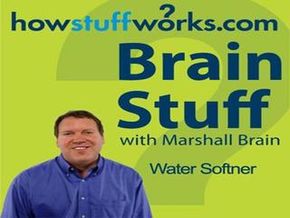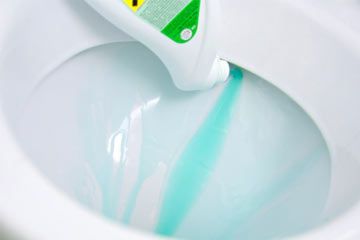The ion replacement takes place within a tank full of small polystyrene beads, also known as tiny resin beads. The negatively charged beads are bonded to positively charged sodium ions. As the water flows past the beads, the sodium ions swap places with the calcium and magnesium ions, which carry a stronger positive charge.
So why do you load up water softeners with salt if the plastic beads do all the work? Over several cycles, calcium and magnesium replace all of the sodium in the beads, after which the unit can no longer soften water. To fix this problem, the softener enters a regeneration cycle during which it soaks the beads in a strong solution of water and salt — or sodium chloride salt.
The sheer amount of sodium in the brine solution generated in the brine tank causes the calcium and magnesium ions in the beads to give way, and the beads are recharged with sodium. After the regeneration process, the water softener flushes the remaining brine, plus all of the calcium and magnesium, through a drainpipe. Water softener regeneration creates a lot of salty water — around 25 gallons (95 liters).
Most home water softeners use the plastic bead and salt approach. The main difference between them is how they decide when to regenerate. Some softeners use electric timers that flush and recharge based on a regular schedule. Others use a computer that judges bead depletion based on water use. Still, others use a mechanical water meter to measure water use and kick off the recharging process only when sodium exhaustion requires it.
Each approach comes with its share of pros and cons. Electronic timer units can't dispense soft water while recharging. Conversely, some computerized systems carry a reserve resin capacity, so you can tap them for a squirt or two of soft water even during recharge cycles. Most flexible of all are mechanical systems, which come equipped with two mineral tanks. One tank can make soft water while the other recharges.
High-efficiency water softeners run between $500 and $6,000 and are designed to be easy to install and remove, which is good news if you want to take your unit with you when you move. However, unless you are confident in your electrical and plumbing abilities, you might want to hire a plumber to get a softener installed. Some stores include installation with the purchase of a water softener.
Sources
- APS Water. "How Select the Best Water Softener." (June 15, 2011)http://www.apswater.com/how_to_select_a_water_softener.asp
- Business Dictionary. "Grains per Gallon." (June 27, 2011)http://www.businessdictionary.com/definition/grains-per-gallon-GPG.html
- Cole, Lucius. "Water Softening -- Effectiveness at What Hardness Level." Water Quality Association. (June 27, 2011)http://www.flawatertreatment.com/pdfs/Water_Softeners_Effextive_at_What_Level_of_Hardness.pdf
- Consumer Reports. "Hard Facts about Hard Water." August 2010. (June 14, 2011)http://www.consumerreports.org/cro/magazine-archive/2010/august/appliances/dishwasher/hard-facts-about-hard-water/index.htm
- ISSA. "ISSA State Phosphate Survey." 2008. (June 17, 2011)http://www.issa.com/data/File/regulatory/phosphate%20surveyAug%202008%20%282%29.pdf
- Klenck, Thomas. "How It Works: Water Softener." Popular Mechanics. Aug. 1, 1998. (June 15, 2011)http://www.popularmechanics.com/home/improvement/interior/1275126
- Lenntech. "Water Softener Frequently Asked Questions." (June 13, 2011)http://www.lenntech.com/processes/softening/faq/water-softener-faq.htm
- Powell, Mike R. "Magnetic Water and Fuel Treatment: Myth, Magic, or Mainstream Science?"
- Sheps, Sheldon G. "Water Softeners: How Much Sodium Do They Add?" Mayo Clinic. (June 27, 2011)http://www.mayoclinic.com/health/sodium/AN00317
- Skeptical Inquirer. Vol. 22, no. 1. January - February 1998. (June 13, 2011)http://www.csicop.org/si/show/magnetic_water_and_fuel_treatment_myth_magic_or_mainstream_science/
- Southern Water (UK). "Fact Sheet: Water Softeners." (July 14, 2011)http://www.southernwater.co.uk/pdf/Environment/drinkWaterQuality/SoftenersWRCnote.pdf
- U.S. Food and Drug Administration. "9. Appendix A: Definitions of Nutrient Content Claims." Food Labeling Guide. October 2009. (June 27, 2011).http://www.fda.gov/Food/GuidanceComplianceRegulatoryInformation/GuidanceDocuments/FoodLabelingNutrition/FoodLabelingGuide/ucm064911.htm
- Wight, Chuck. "How Do Water Softeners Work?" Scientific American. Sept. 24, 2001. (June 16, 2011)http://www.scientificamerican.com/article.cfm?id=how-do-water-softeners-wo
- Wisconsin Bureau of Wastewater Management. "Water Softeners and the Environment." Wisconsin Department of Natural Resources. (June 15, 2011)http://www.clearwaterpoolsystems.com/Pdf/GoingGreen/WaterSoftenersandtheEnvironment.pdf



